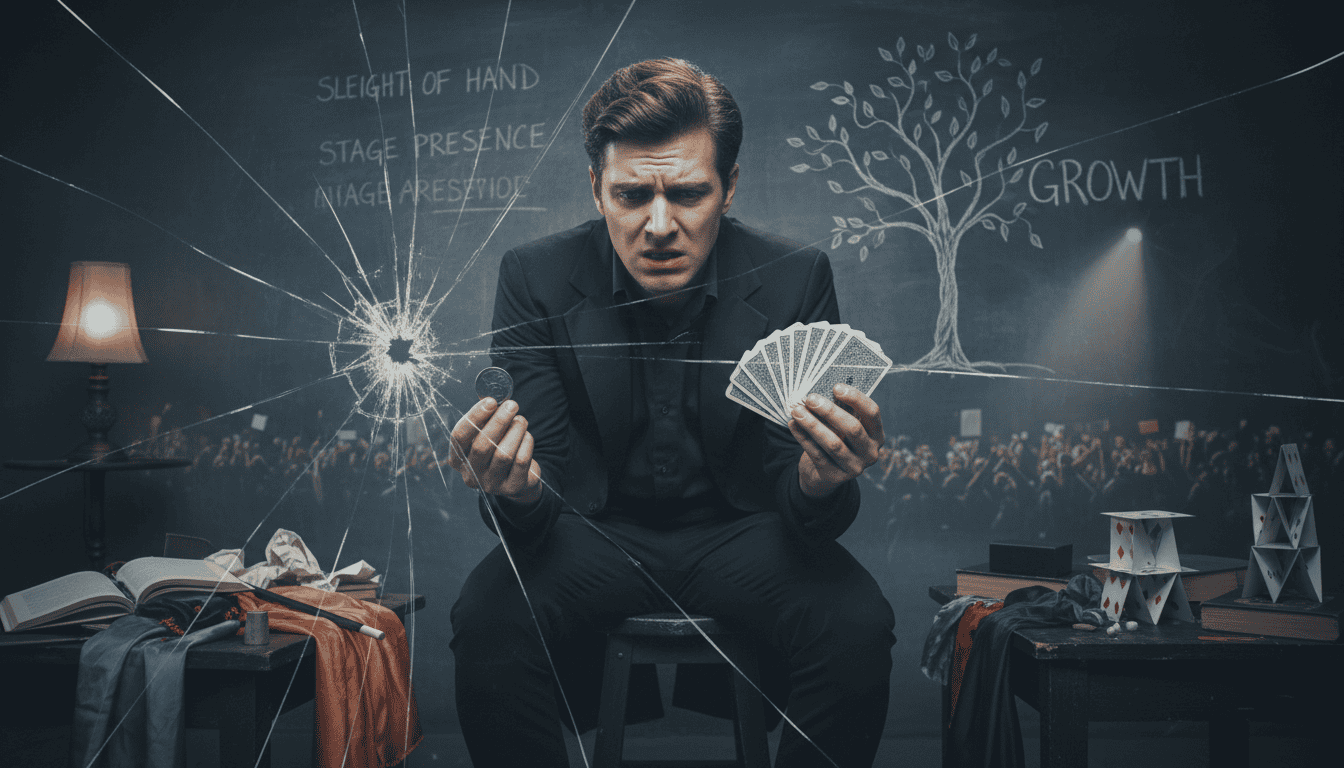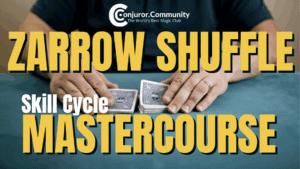Other blogs in this series:
- Why “Natural” Is the Last Thing You Should Try to Look →
- The Real Secret to the Zarrow Shuffle →
- From Frustration to Flow →
The myth that hides real mastery.
Every magician worries about looking natural.
We obsess over it.
We film from every angle, hunt for flashes, and try to move the way “real” people move when they aren’t thinking about being watched.
And yet — after decades in this craft — I’ve learned the irony hiding in plain sight:
The harder you try to look natural, the less natural you’ll ever be.
The Myth of Naturalness
When we say a sleight looks “natural,” what we’re really describing isn’t nature — it’s uniformity.
The rhythm, the pressure, the timing — everything matches.
Every detail flows the same way as every other.
Nothing contradicts.
That perfect sameness tricks the eye. It feels organic because it’s consistent.
But here’s the twist: to achieve that level of uniformity, you usually have to change the real action.
The normal, sloppy, everyday version simply won’t do.
Think of it like a movie backlot.
The street you see on screen looks alive — graffiti, grime, cracks in the pavement.
But every brick was built to spec, perfectly aligned so a camera rig can roll through.
Only after it’s built do the set designers add the dirt and scuffs that make it feel real.
That’s what we do with sleight of hand.
We engineer the illusion first — then layer in the irregularities that make it breathe.
Uniformity and the Real World
This is what I mean when I tell students that naturalness is invented.
The audience never knew what “natural” looked like until you showed them.
They see your version of the move, believe it’s genuine, and from that moment forward, it becomes their new reference point.
In truth, most “real” actions are a mess.
A genuine riffle shuffle — the kind your uncle does at the kitchen table — is rough and noisy, with uneven pressure and awkward angles.
If you copy that literally, your false shuffle won’t deceive anyone.
To create the illusion of that casual imperfection, you must first rebuild the action so every line and rhythm fits together perfectly — then add the hint of imperfection back in.
That’s the great paradox of mastery: the realistic is almost never the real.
Discovery Beats Repetition
Here’s where most magicians go wrong.
They take a principle like this, then “drill” it — over and over — until the motion becomes automatic.
But repetition alone doesn’t create mastery.
It only bakes in habits, good or bad.
We talk about this all the time in our Max Thursday Practice Sessions.
Practice is not rehearsal. Practice is discovery.
When you’re discovering, you’re exploring the edges — feeling the moment where things start to click.
You’re paying attention to the feedback from sound, pressure, and flow.
It’s like slow-setting epoxy: it stays flexible long enough to find the perfect fit before it hardens into habit.
That’s how the natural dealing position — or the perfect shuffle rhythm — truly emerges.
Not from grinding the same motion 10,000 times, but from staying curious long enough for the right version to become unconscious.
Walking works the same way.
It takes about thirteen years of tripping, scraping, and balancing before we stop skinning our knees.
After that, it feels effortless — but only because every mistake along the way taught our bodies what “natural” really is.
Why Steve’s Zarrow Proves It
If you want to see this principle alive in real time, watch Steve Reynolds teach the Zarrow Shuffle.
Among card magicians, Steve’s version is considered the benchmark — the one that looks exactly right because it is exactly right.
Here’s why: Steve doesn’t start by teaching a false shuffle.
He starts by rebuilding the real shuffle — grip, rhythm, pressure, posture — from the ground up.
Only when that honest, mechanical action is perfectly understood does he show how to blend the Zarrow into it.
He’s not disguising the move.
He’s aligning two actions — the real and the false — until they’re indistinguishable.
That’s what true invisibility looks like.
Nothing is hidden because nothing looks different.
Most magicians never reach that point because they try to make the false look like the real before they’ve ever learned the real.
Steve reverses that order, and the result is astonishing: a shuffle that sounds right, feels right, and remains invisible even when you know what’s happening.
Where Feedback Finishes the Illusion
This kind of learning doesn’t happen in isolation.
It happens in real time — with feedback.
When you watch others make the same mistakes you’re making, and you see the tiny corrections that fix them, something clicks.
That moment — hearing the right sound, seeing the right rhythm — locks the pattern into your nervous system.
You can feel when you’re doing it right long before you can see it.
That’s why our Thursday Practice Engine sessions in CC MAX work so well.
They create the feedback loop every magician needs: discovery, correction, repetition — all at once.
Practice with discovery built in.
Join CC MAX and experience live guided training every Thursday.
The Rarity of the Truly Invisible
Most sleights in magic aren’t truly invisible — they’re imperceptible.
They work because the audience’s attention is gently pulled elsewhere at the critical moment.
You can see them, technically, but you don’t notice them.
Your attention is focused just a few degrees away — like a camera whose lens is trained on the wrong subject.
You’d swear you saw everything clearly, and you did — except the part that mattered.
But a handful of techniques in magic go beyond that.
They don’t rely on attention misdirection at all.
They’re invisible by design.
Vernon’s Top Palm.
The Gravity Half Pass.
The Elmsley Count.
And the Zarrow Shuffle.
In each of these, the method and the action are the same thing.
Even under scrutiny, there’s nothing to catch.
Done well, they leave no tell, no discrepancy, no visual contradiction.
They are the rare sleights that can be performed in slow motion — and still fool the eye.
That’s why Steve’s approach to the Zarrow matters so much.
It’s not just a great shuffle; it’s a case study in how naturalness is engineered.
Learn the Ultimate Invisible Shuffle
Explore Steve Reynolds’ complete Zarrow system — with guided commentary from Aaron Fisher and Alex Slemmer.
Regular Price $397
Today: $297
When You Stop Trying to Look Natural
Every magician starts by fixing technique — thumb here, wrist there, don’t flash that corner.
But there comes a point when correction gives way to intuition.
You stop fixing.
You start feeling.
That’s the moment when practice becomes artistry — when the motion, rhythm, and sound align so completely that you don’t have to manage them anymore.
Naturalness isn’t something you show.
It’s something that shows through you.
So stop trying to look natural.
Start exploring, listening, and refining until every detail agrees with every other.
When everything moves together, nothing stands out — and that’s when the magic finally disappears in plain sight.
And if that sounds abstract, it’s not.
It’s the next step every magician eventually faces:
Once you stop trying to look natural…
how do you look real?
(That’s where we’ll go next.)
Next in this series: The Real Secret to the Zarrow Shuffle →

